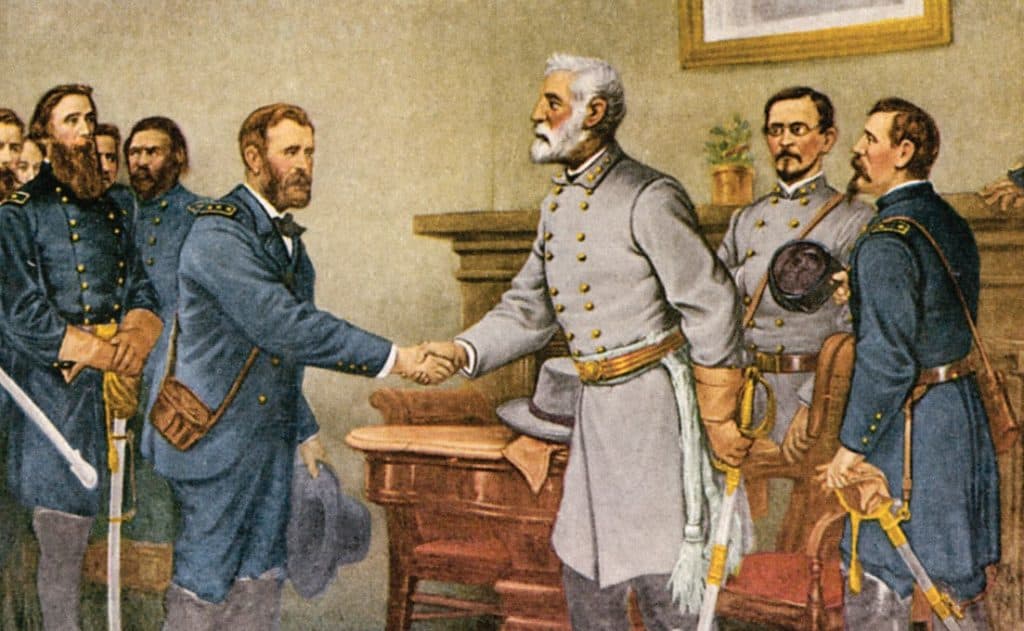
5 Characteristics of Biblical Discipline
Sometimes it’s hard to know if you’re disciplining your children effectively. Try using these five measures from the Bible.

In our fractured world, we can echo Grant’s plea for harmony in the immortal words that grace his tomb in New York City, “Let us have peace.”
As we remember the men and women of our armed services who gave their lives to preserve our freedom, we recognize that we continue to live in tumultuous times. Conflict is inevitable in this fallen world. How do we teach our children to shine the light in the darkness to preserve freedom—just as so many courageous individuals have done in the past? One way is to share examples of those who can serve as role models and guides as we strive for peace in our time.
One shining example whose life speaks to our times is Ulysses S. Grant. Parents can use this man of faith and integrity as an example of how a life well-lived can touch the lives of many other people. Carved into the front of the General Grant National Memorial in New York City—known by most as ‘Grant’s Tomb’—is the slogan from his first presidential campaign:
Grant rose to the become General-in-Chief of the Union Army, leading more than a million soldiers in a Civil War fought over the same issue that we still struggle with today: race. We have much to be thankful for in the way Grant lifted the banner of freedom for African-Americans – and all people – 80 years before the passing of the Civil Rights Act in 1964.
Grant, who had been ambivalent towards abolition, had an instant change of heart when the slave-holding Confederacy fired upon Fort Sumter. Years after the Civil War, and after he had served two terms as President—defending and protecting the former slaves—Grant explained his position in a meeting with German Chancellor, Otto von Bismarck.
“…you had to save the Union just as we had to save Germany,” von Bismarck observed.
“Not only save the Union, but destroy slavery,” Grant explained.
Bismarck was taken aback by the comment. “I suppose, however, the Union was the real sentiment, the dominant sentiment.”
“In the beginning, yes,” Grant agreed, “but as soon as slavery fired upon the flag … we all felt, even those who did not object to slaves, that slavery must be destroyed.”
Grant’s views on the slavery issue had evolved as the war progressed and he grew to respect and adopt Lincoln’s policies. These views matured further during his time as president as he took a bold stand to protect black civil rights and to defeat the Ku Klux Klan.
“There had to be an end to slavery,” Grant explained. “Then we were fighting an enemy with whom we could not make a peace. We had to destroy him. No convention, no treaty was possible – only destruction.”
Grant grew to oppose slavery on practical, military, and religious grounds. As early as the summer of 1861, he told an army chaplain “he believed slavery would die with this rebellion, and that it might become necessary for the government to suppress it as a stroke of military policy.”
Grant had married into the slave-holding Dent family and had been given a slave by his father-in-law. But as the issue of slavery began to tear the country apart in the years just prior to the outbreak of war, Grant decided to free his slave. This was at a time of extreme financial difficulty for Grant. The sale of a slave could bring in as much as $1,000 – a sum that would have relieved a great amount of pressure on his family. Yet Grant emancipated his slave instead – a move that foreshadowed his growing anti-slavery sentiments.
Grant’s brother-in-law Michael John Cramer confirmed that “as the war progressed [Grant] became gradually convinced that ‘slavery was doomed and must go.’ He had always recognized its moral evil, as also its being the cause of the war.”
General Grant, like Lincoln, came to look upon the war as a divine punishment for the sin of slavery.
In a letter to his friend, Congressman Elihu Washburne, soon after Lincoln issued the Emancipation Proclamation, Grant shared his belief that since slavery was the root cause of the war, its destruction had become the basis for settlement with the South.
It was “patent to my mind early in the rebellion that the North & South could never live at peace with each other except as one nation, and that without slavery. As anxious as I am to see peace reestablished, I would not therefore be willing to see any settlement until this question is forever settled.”
Grant saw the drift toward what became known as ‘The Lost Cause’ defense of the war in the final years of his life. He eloquently reminded the country of the true cause of the war in his famous Personal Memoirs.
“The cause of the great War of the Rebellion against the United States will have to be attributed to slavery. For some years before the war began it was a trite saying among some politicians that ‘A state half slave and half free cannot exist.’ All must become slave or all free, or the state will go down. I took no part myself in any such view of the case at the time, but since the war is over, reviewing the whole question, I have come to the conclusion that the saying is quite true.”
The greatest African-American mind of the 19th Century, Frederick Douglass, eulogized Grant as “a man too broad for prejudice, too humane to despise the humblest, too great to be small at any point. In him the Negro found a protector, the Indian a friend, a vanquished foe a brother, an imperiled nation a savior.”
In the last two years of his life, Grant suffered the kind of setbacks that might destroy a person of weaker character. In May of 1884, the General’s Wall Street investment firm, Grant & Ward, went bankrupt after it was discovered that their business partner had been running a giant Ponzi scheme. Only a few months later, Grant was diagnosed with incurable throat cancer. Nearly penniless and dying, Grant agreed to write his memoirs and publish them with Mark Twain’s publishing company.
Grant spent the final year of his life—when he had the strength—writing his personal memoirs with a pencil and a legal pad. He refused to take morphine during the day so he could think clearly—but this left him in terrible pain as he did his work.
Grant suffered a particularly painful and debilitating episode on Memorial Day, 1885. As the heat was growing in New York City that early summer, Grant laid in bed in terrible pain. Suddenly he heard music and cheering emanating through the open window from the street below. General Horace Porter, Grant’s trusted friend, was visiting with Grant as the military sounds echoed outside.
Out on the street, men wearing the dark blue uniforms and wide-brimmed hats of the Grand Army of the Republic marched down Fifth Avenue, with bands playing and the crowd cheering. As unit after unit came to Sixty-Sixth Street, they turned left off their usual route, passing in review before Grant’s house.
“Now he heard the sound of martial music,” Porter remembered. “Then came the heavy, measured steps of moving columns, a step which can be acquired only by years of service in the field. He recognized it all now. It was the tread of his old veterans.”
“With his little remaining strength he arose and dragged himself to the window. As he gazed upon those battle-flags dipping to him in salute, those precious standards bullet-riddled, battle-stained … his eyes once more kindled with the flames that had lighted them at Shiloh, on the heights of Chattanooga, amid the glories of Appomattox.”
With great difficulty, Grant rose and shuffled to his second-story window. Standing next to Porter, the General-in-Chief of the army that saved the Union gazed down at his beloved “Boys in Blue.” As each regiment passed, they performed a machine-like “eyes left” maneuver, turning their heads toward the general and taking off their hats to him as they marched passed.
Porter sketched the scene. “As those war-scarred veterans with uncovered heads and upturned faces for the last time looked upon the pallid features of their old chief, cheeks which had been bronzed by southern suns and begrimed with gun powder, were bathed in tears of manly grief.”
“Soon they saw rising the hand which had so often pointed out to them the path of victory. He raised it slowly and painfully to his head in recognition of their salutations.” After all the columns had passed, General Grant’s hand fell heavily to his side. That would be his last military salute.
A reporter from the New-York Tribune, stationed with the rest of the press across the street, witnessed the scene.
“The old warrior stood at his post in the window, like a statue, looking toward the Park. Someone came up from behind and touched him, and he moved slowly away. The sight of the old soldiers, many of whom had been with him in the Wilderness, touched him deeply, and he sat thinking in his chair for a long time after the sound of the music had died away in the distance.”
This would be Grant’s final Memorial Day. He would pass away in July of 1885 and his funeral would be the largest in American history, filling the streets of Manhattan with more than 1.5 million people. Mark Twain would publish the Personal Memoirs of Ulysses S. Grant later that year. It would become the second biggest seller of the Nineteenth Century, make a profit of more than $450 thousand dollars for Julia Grant (the equivalent of more than $10 million today).
Today, we recognize Grant as the general who, along with President Lincoln, won the Civil War and saved the Union. He picked up the banner of racial equality after the death of Lincoln, holding the nation together during the dangerous years of Reconstruction. He is considered one of the greatest defenders of civil rights to ever hold the office of president.
As parents, we can teach our children that we owe a great debt to Ulysses S. Grant for giving us an example to help us achieve peace in our time. This Memorial Day, we can model to our children our gratitude for men and women of character who gave so much to preserve our freedom. In our current fractured world, we can all echo his plea for harmony in the immortal words that grace his tomb in New York City, “Let us have peace.”